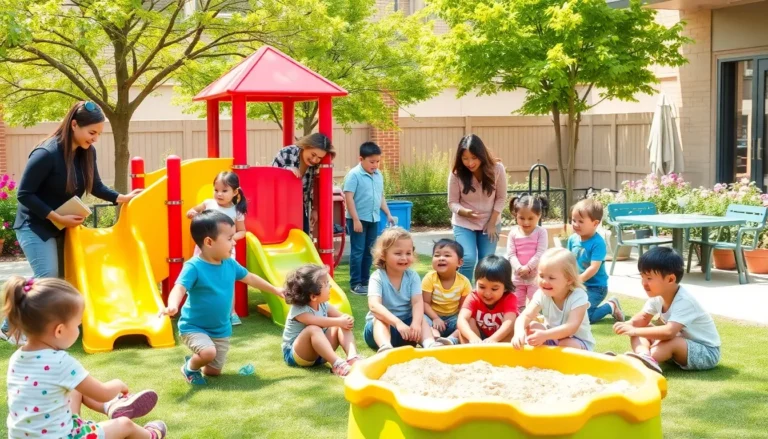In a world where fast fashion reigns supreme, fashion sewing patterns offer a delightful escape into creativity and individuality. Imagine crafting your wardrobe from scratch, strutting down the street in outfits that scream “one-of-a-kind.” It’s like being a fashion superhero, armed with fabric and a sewing machine instead of a cape.
But don’t let the thought of sewing send you running for the nearest store. With the right patterns, anyone can transform from a novice to a sewing sensation. Whether it’s a chic dress or a tailored blazer, fashion sewing patterns unlock a treasure trove of possibilities. So grab those scissors and let’s dive into the world of sewing where style meets self-expression—because who wouldn’t want to wear something that fits them perfectly and tells their unique story?
Table of Contents
ToggleOverview of Fashion Sewing Patterns
Fashion sewing patterns serve as essential templates for creating clothing, bridging creativity and craftsmanship. They allow individuals to design custom garments while ensuring proper fit and style.
History of Fashion Sewing Patterns
Fashion sewing patterns date back to the 19th century when commercial patterns emerged. Initially, patterns were basic shapes drawn on paper. The 1860s marked the introduction of pre-printed patterns by companies like Butterick. With industrialization, patterns became widely available, catering to diverse styles and body types. Over time, the development of techniques and technologies enhanced pattern accuracy. Today, digital patterns offer convenience while preserving the tradition of sewing.
Importance in the Fashion Industry
Fashion sewing patterns play a vital role in the industry by fostering creativity and self-expression. Designers rely on patterns to translate their concepts into wearable items. Consumers benefit from patterns that enable personalized clothing options. This adaptability promotes sustainability by encouraging home sewing instead of mass-produced garments. Patterns also support skill development, helping sewists improve techniques through practice. Overall, they contribute to a more diverse and sustainable fashion landscape.
Types of Fashion Sewing Patterns

Fashion sewing patterns come in various designs, catering to different needs and preferences. Understanding these types helps sewists choose the right patterns for their projects.
Commercial Patterns
Commercial patterns represent a significant segment of the sewing pattern market. Major brands manufacture them, ensuring broad availability in fabric stores and online. These patterns often feature a range of styles designed for various skill levels, like beginner to advanced. Sewists rely on commercial patterns for their accuracy and consistency, thanks to established grading techniques. Typical options include dresses, skirts, pants, and tops, appealing to different occasions. Patterns from the same brand usually share sizing and design aesthetics.
Independent Patterns
Independent patterns offer a unique alternative to commercial options. Smaller companies or individual designers create these patterns, showcasing distinctive styles. Often, they prioritize niche markets, featuring contemporary trends and unique designs not found in commercial collections. They typically include downloadable PDF formats, providing instant access for users. Independent patterns frequently emphasize inclusivity, offering wider size ranges and diverse styles. Moreover, these patterns often come with detailed instructions and supportive communities, aiding sewists in their crafting journey.
Choosing the Right Fashion Sewing Pattern
Selecting an appropriate fashion sewing pattern ensures successful projects and enjoyable sewing experiences. Various factors impact this decision, including skill level and fabric compatibility.
Skill Level Considerations
Skill level significantly influences pattern selection. Beginners often benefit from patterns labeled as “easy.” These patterns typically feature simpler construction and fewer pieces. Intermediate sewists may prefer patterns with more intricate details that encourage skill development. Advanced sewists can experiment with complex designs, allowing for creative expression. Patterns often indicate recommended skill levels, making it easier to choose based on expertise. Patterns designed for all skill levels provide a well-rounded experience and opportunities for growth.
Fabric and Material Compatibility
Fabric choice affects the final outcome of any sewing project. Different patterns recommend appropriate fabrics to ensure optimal draping and fit. Lightweight fabrics, such as cotton poplin, suit summer dresses or blouses. Heavier materials, like denim or wool, work well for structured garments. It’s crucial to check the pattern envelope for suggested fabric types and their weight. Patterns may also specify necessary stretch or specific characteristics, like breathability. Following fabric guidelines enhances the success of the finished item and increases satisfaction with the sewing process.
Tips for Using Fashion Sewing Patterns
Using fashion sewing patterns can enhance creativity and make the sewing process more enjoyable. Understanding the specifics within each pattern is crucial for successful results.
Understanding Pattern Symbols
Pattern symbols indicate various instructions and features throughout the sewing process. This includes markings for darts, notches, and fold lines. Familiarity with these symbols ensures proper assembly and fit, minimizing surprises during construction. Consider referencing a symbol guide to clarify meanings for specific patterns. Many patterns also include a glossary that explains less familiar symbols. Attention to these details can streamline workflow and improve final garment quality.
Modifying Patterns to Fit Your Style
Customizing patterns transforms standard designs into unique creations. Start by altering the fit through adjustments like adding or removing ease at seams. Lengthening or shortening specific components, such as sleeves or hems, further enhances personalization. Techniques such as adding pockets or changing collars can significantly impact overall style. Experimenting with these modifications can lead to one-of-a-kind pieces that truly reflect individual tastes. Document any changes made for future reference and refinement.
Popular Fashion Sewing Pattern Brands
Numerous brands dominate the fashion sewing pattern landscape, each offering unique features and styles. These brands cater to various skill levels and personal tastes, empowering sewists to create stunning garments.
Vogue Patterns
Vogue Patterns stands out for its chic and sophisticated designs. Known for innovative styles and high fashion, this brand appeals to advanced sewists seeking unique looks. Vogue provides a wide range of patterns, including dresses, skirts, and jackets, often inspired by runway trends. The patterns feature detailed instructions, ensuring fewer mistakes during the sewing process. When using Vogue, sewists gain access to contemporary techniques that enhance overall garment quality.
McCall’s Patterns
McCall’s Patterns is popular for offering something accessible to all sewists. Emphasizing ease of use, this brand focuses on beginner-friendly designs without compromising style. The collection includes a variety of clothing types, from casual wear to formal garments. Riders and instructions guide users through the sewing adventure, making it an excellent choice for novice crafters. With its versatility and inclusivity, McCall’s continues to support the sewing community while inspiring creativity among users.
Fashion sewing patterns open a world of creativity and self-expression. They empower individuals to craft unique garments that reflect personal style while promoting sustainable practices. By understanding the different types of patterns and their history, sewists can make informed choices that enhance their sewing journey.
Choosing the right pattern is crucial for success and satisfaction. Whether opting for commercial or independent designs, each offers a unique opportunity to explore fashion in a hands-on way. With the right tools and knowledge, anyone can transform fabric into a one-of-a-kind piece that stands out in a sea of fast fashion.
Embracing fashion sewing patterns not only nurtures individual creativity but also fosters a sense of community among sewists. This craft continues to thrive, encouraging more people to join in and celebrate the art of making.




